|


|
| Connecting The Dots |
Anthrax City Then & Now
UNDER CONSTRUCTION

" You don't always need totally new information
to make progress,
sometimes you just need to
know more about old information .."
-Ed Lake www.anthraxinvestigation.com
'There are some things so serious
you have to laugh at them.'
-Niels Bohr
Physicist
Scientific Advisor
Manhatten Project Los Alamos

2005
U.S. Army Medical Research Institute of Infectious Diseases Confirms Positive Anthrax Tests:
2005
Two labs confirmed Pentagon anthrax
By Dee Ann Divis
Senior Science & Technology Editor [UPI]
Published 3/21/2005 12:18 PM
WASHINGTON, March 21 (UPI) -- Anthrax has been confirmed in samples collected from the two Pentagon mail facilities that
were at first closed last week and then declared free of the pathogen, United Press International has learned.
The head of the company that was accused of contaminating the samples sent from those facilities -- a detached building
on the Pentagon grounds in Arlington, Va., and the other in Falls Church, Va. -- said the presence of anthrax was detected
independently by two government laboratories.
***
"It is a fact that we had a presumptive positive test come up," he said. "That presumptive positive test
was confirmed by us and by at least two other labs as being a true positive."
Carlee Vander Linden, a spokeswoman for the U.S. Army Medical Research Institute of Infectious Diseases in Frederick,
Md., which tested the samples after CBI, confirmed that the follow-up tests on the first sample were positive and that two
labs had done such tests."
BIOCHEMICAL ATTACKS
The Anthrax Attacks of 2005
"The Elephant in the Room"
by Sean Osborne, Military Affairs Expert, Senior Analyst
23 March 2005: Youve probably heard a casual mention on one of the evening news programs recently of an incident involving
a report of anthrax being found at the Pentagon and two other facilities in Washington, DC last week. This report was quickly
followed by reports that the alarm was really the cause of false positive test results and the incident was actually a non-event.
Lacking true investigative journalists for the most part, the press rarely follows through on getting answers to the more
difficult questions and accepts the official denials, moving on to cover more sensational stories such as the Michael Jackson
trial and the sad case of Terry Schiavo as the talk of terrorism is beginning to get tiresome anyway. More importantly, though,
this most recent anthrax case brings to mind the old phrase about the presence of there being an elephant in the room,"
which is used to describe a situation where there is a very large problem or situation, but everyone pretends that it really
isn't there, and no one really wants to talk about it. Such describes the anthrax incident that began in Washington, DC on
Thursday, March 10, 2005.
Incident is, of course an improper term should the facts ever show that the false positives and accusations of cross contamination
prove to be government doublespeak superficial denials as we have come to know them. Biological attack is a more appropriate
phrase, although no one dares utter that on the record. Rather, the official line is to blame an independent laboratory, Commonwealth
Biotechnologies Inc. (CBI), one that has conducted over 2,000 such tests in the past two years and tens of thousands of others
and has never experienced a false positive test result. Further, those results were also verified by two other independent
laboratories as being true positive. We were also treated to an interesting confirmation from a spokeswoman for the U.S. Army
Medical Research Institute of Infectious Diseases (USAMRIID) in Frederick, Maryland, Carlee Vander Linden. She stated that
they tested the samples after CBI reported the tests for anthrax as positive, and confirmed that their follow-up tests on
the first sample were also positive and admitted that two other labs had done such tests and received the same conclusively
positive results.
Summarized Chronology of Events
It began on Thursday, March 10, 2005 when CBI collected initial samples consisting of swabs of surfaces from the Pentagon
mail facility (detached from the Pentagon but located on the same grounds) in Arlington, Virginia and at a mailroom in a Defense
Department-leased building in Falls Church, Virginia, which is part of a three-building complex. Those tests were completed
in 24-hours and read “positive for bacillus anthracis (anthrax).
According to Robert B. Harris, president and chief executive officer of Commonwealth Biotechnologies Inc. (CBI) in Richmond,
Virginia, the conclusive results were reported to the appropriate authorities the very next day, on March 11, 2005. Further,
stated Harris, not only were the tests presumptively and conclusively proved positive, the the anthrax found at the Pentagon
was the same genetic strain used in the 2001 attacks.
Then on Friday, March 18, 2005, yet another alarm sounded at Bolling Air Force Base, which is located along the Anacostia
River in Washington. The alert occurred in a mail-handling facility used by the Defense Intelligence Agency at that location.
DIA spokesman Major Paul Swiergosz verified that the DIA remote-delivery facility was closed due to an initial positive test
of incoming mail for hazardous biological agents." He added that all people who were working and inside of the building
were asked to stay, and based on an independent report to the Northeast Intelligence Network, actual decontamination procedures
were utilized at this facility.
Conflicting Stories
According to officials reporting these incidents, all appear to be the result of cross-contamination somewhere in the
Defense Department mail system. There were three alerts: one at the Pentagon, one in Falls Church and one at Bolling Air Force
Base, and all three were specific for anthrax. The official storyline is that all three tests were posiive for anthrax, but
that cross-contamination of the collected samples appeared to be the cause.
That explanation sounds reasonable until more probing questions are asked and the procedures inspected a little closer.
It is critical to note that two of the three alerts resulted from biosensor readings located Falls Church and at Bolling in
the facilities and were totally unrelated to CBI testing. Accordingly, the issue of cross-contamination by CBI, then, is not
possible. And despite the reports of false positives, the entire three-building complex at Falls Church remained closed for
two days and decontamination procedures were implemented.
On Monday, March 14, 2005, Douglas J. Hagmann, Director of the Northeast Intelligence Network independently confirmed
that the Falls Church facility at the Skyline Plaza was in lock down for at least six hours and about 25 building occupants
were being actively decontaminated. An official source at the scene who spoke on the condition of anonymity stated that this
is the first time this has happened in this area since the first time in 2001.
Despite the downplaying of these events and the allegations of cross contamination by CBI, Pentagon officials continue
to this day to gather thousands of pieces of mail that moved through the detached facility between March 10 and March 14,
2005 for review and further testing.
Disturbing Scenario
In summary, we have a situation where an independent laboratory with an impressive track record collected surface swabs
from two Defense Department mail facilities that conclusively tested positive for anthrax. Further, this was not just any
old strain of anthrax, but the very same genetic strain of bacillus anthracis that was used in the biological attacks in 2001,
a crime still unsolved. CBI President was emphatic about his results, and noted that not only his lab, but tests by two other
laboratories came up with the same results: "It is a fact that we had a presumptive positive test come up," he said.
"That presumptive positive test was confirmed by us and by at least two other labs as being a true positive."
Finally, we have Carlee Vander Linden, from the U.S. Army Medical Research Institute of Infectious Diseases in Frederick,
Md., which tested the samples after CBI and confirmed that the follow-up tests on the first sample were indeed positive and
also confirmed Harris's assertions that two other labs had done such tests. Referring to the possible cross-contamination
issue, she interestingly and carefully made the following statement:
"USAMRIID is not saying that, 'Gee, there probably was a contamination event.' I think some people are surmising
that. It certainly has been reported that way. I think that we'll just have to wait and see."

2001 -
"Anthrax was found around the supreme court's mail
The BBC's Tom Carver finds life in the US capital remarkably calm given the continuing threat of anthrax and the war rumbling
on in Afghanistan.
Welcome to anthrax city, where the postman doesn't knock twice. Or even once.
In fact, he hasn't knocked all week at our front door.
In some ways, it is rather a blessing not to have all that junk mail...."
Saturday, 27 October, 2001,
GMT 15:38 UK
2005 -
The Downtown Public Library in Nashville
had to be evacuated Saturday morning,
after a suspicious package was found.
A powdery substance and a note that read
"Welcome to Anthrax City", was inside
the package.'
News Channel 5 Nashville - Apr 09 5:24 PM 2005

___________________________________________________________
June 14, 2005
White Powder Anthrax Hoaxes
Earlier this month, there was an anthrax scare at the Indonesian embassy in Australia. Someone sent them some white powder
in an envelope, which was scary enough. Then it tested positive for bacillus. The building was decontaminated, and the staff
was quarantined for twelve hours.
__________________________________________________________
March 15, 2005
Anthrax alarm closes three mail facilities
By Daniel Pulliam
Anthrax detection systems at two Pentagon mailrooms sounded
alarms Monday, resulting in the evacuation of four buildings and the shutdown of the Postal Service's facility that handles
government mail.
Initial overnight tests on the samples from the Pentagon's Remote Delivery Facility in Arlington, Va., turned up positive,
according to officials at the Health and Human Services Department. Tests on a second set of samples from the Pentagon-leased
Skyline office complex in Falls Church, Va., discovered hours after the first alarm sounded, are not yet complete.
The positive samples are being tested at the Army's Medical
Research Institute of Infectious Diseases at Fort Detrick, Md., to determine whether the spores are capable of causing
disease.
Results from this type of test usually take 24 to 48 hours, but an HHS spokesman said results could be available later
today."

| "What are you gawking at?" |

|
| "Move along - there's nothing to see here?" |
___________________________________________________________
WASHINGTON, March 14, 2005 - Defense Department officials confirmed that a positive test for the presence of anthrax bacteria
during routine mail operations today led to the evacuation of a Pentagon outbuilding.
American Forces Press Service
___________________________________________________________
DOD says:
Positive Initial Detection for Anthrax at Pentagon During routine mail operations the Pentagon had a positive detection
for the presence of anthrax bacteria at the Remote Delivery Facility (RDF).
The RDF was evacuated while tests were conducted to determine if anthrax was present.
__________________________________________________________
Then And Now -
Remember Anthrax?
Dead subject?
Not likely:

"Two Labs Confirm Anthrax In The Mail"
"Anthrax alert at Bolling Air Force Base The third in the Washington, D.C."
"Meanwhile, the president and CEO of Commonwealth Biotechnologies Inc. rejected suspicions that his firm might had accidentally
contaminated samples from the Pentagon mailroom while testing them for anthrax, United Press International reported. Robert
Harris said two government laboratories also independently detected anthrax on the samples. Testing at Commonwealth Biotechnologies
has never led to a false positive, he said It is a fact that we had a presumptive positive test come up, Harris said. That
presumptive positive test was confirmed by us and by at least two other labs as being a true positive. A spokeswoman for U.S.
Army Medical Research Institute of Infectious Diseases in Maryland confirmed the additional testing."

| "Who - me?" |

|
| "That stupid profile fits thousands of people - millions!" |
"From where I sit, the Linguistic/Behavioral Analysis of Anthrax Letters appears to be etched in granite.
In well over two years not one letter, let alone one word, has been so much as chipped.
Despite a changing of the guard, not one word has been added.
May mean nothing - or may speak volumes."
-Protection Technologist
OVER THE PAST SIX (Now 30) MONTHS, have federal authorities altered their working theory of last fall's anthrax murders?
No, not much. On November 9 last year, even before the anthrax outbreak's fifth and final fatality had been recorded,
the FBI called a press conference to unveil its "linguistic and behavioral assessment" of "the person"
purportedly responsible.
It was "highly probable, bordering on certainty," the Bureau announced, that a single "adult male"
had prepared and mailed all the contaminated letters at issue.
This man "probably has a scientific background," "may work in a laboratory," and is familiar with
the area around Trenton, New Jersey--where the envelopes were postmarked.
He suffers a pronounced psycho-social deformity: "He lacks the personal skills necessary to confront others"
and "if he is involved in a personal relationship, it will likely be of a self-serving nature."
Moreover, crucially, the suspect appears to be an American. "We're certainly looking in that direction right now,
as far as someone being domestic," said James R. Fitzgerald, head of the FBI's Behavioral Analysis Unit."
___________________________________________________________
Both Then And Now{ FBI: Loner in U.S. sent tainted mail TA profile of the person who mailed anthrax letters points to a domestic
opportunist. Compiled from Times wires © St. Petersburg Times, published November 10, 2001 WASHINGTON -- FBI officials said
Friday that they believe the person who mailed several anthrax- filled letters is probably a U.S.-based male loner with a
scientific bent, possibly like Unabomber Ted Kaczynski, whose letter bombs mystified law enforcement for nearly two decades.
___________________________________________________________
" FBI profilers have developed a profile of the bioterrorist that seems largely based on the Unabomber "
| Unabomber |

|
| Ted Kaczynski. |
| SKETCH |

|
| UNABOMBER |

"KACZYNSKI comes to the Lincoln Public Library,
he dresses in jeans and a flannel shirt... "
-SHERRI WOOD
FEDERAL BUREAU OF INVESTIGATION
SHERRI WOOD INTERVIEW
April 2, 1996
Librarian at the Lincoln, Montana,
branch of Lewis and Clark Library
in November of 1984.
| Unabomber |

|
| Flannel Shirt |
| Angry Loner With Scientific Knowledge |

|
| Victor |



|
| Submit A Tip |
"Dr. Kenneth I. Berns, president of the Mount Sinai Medical Center in New York City, said he judged the probability
that Iraq possessed weaponized smallpox as "reasonably high" and that Saddam Hussein would use such germs in a war
against the United States as "quite high."
"Oh dear. Better hope he doesn't have anything genetically-engineered to evade the vaccine.
I use genetically-engineered viruses in my work, and it is rather frightening how easy it is with current technology to
play mix and match with these things.
For instance, it is quite routine to take an ecotrophic virus (one that only infects a single species) and turn into an
amphitrophic virus (one that infects a wide range of species) simply by swapping out the genes that code for the coat proteins.
If Saddam is operating at that level of technology, I venture to say we could lose about a third of the population in the
coming showdown -- comparable to a full-scale nuclear exchange.
If he has only conventional smallpox, anthrax, botulism, etc., then we may be able to contain the threat to something
managable by building up our civil defense infrastucture. Even then, I don't think we're near that point -- perhaps in a couple
of years. I expect Bush to keep up the rhetorical heat on Saddam and pursue every avenue to put the squeeze on him, including
military pressure, but I thing those who are expecting a big assault in the next 12 months will be disappointed.
Way too dangerous, I'm afraid."
Posted by The Great Satan to kattracks; Mitchell; Nogbad; EternalHope; cicero's_son On News/Activism 07/06/2002 11:02
PM EDT #7 of 127
_____________________________________________________
CONFUSED?
'Victor, a "microbiologist" who worked for a large New Jersey based pharmaceutical company, has been posting
profusely on the Internet using the screen name or alias
"The Great Satan".
He has been posting for over 10 years under a slew of other aliases.
By his own admission,Victor, a research scientist, is addicted to the Internet.
In fact, he "lives" on the Internet via his penchant for role playing and engaging in dark games. He even realistically
argues with himself and posts misleading material in an effort to, in his words, "Inflate confusion".
His favorite forum is the politically active ultra-conservative 'news' website http://www.freerepublic.com . Although
he purposefully managed to get "The Great Satan" persona banned on Freerepublic, he continues to post under a variety
of other screen names.
Prior to adopting the Satan persona in December of 2001, soon after the FBI published the Behavioral Profile of the anthrax
mailer, he posted as "Clinton's a rapist" and under numerous other "screen names". Four of his current
screen names are 'The_Victor','jpl', "NativeNewYorker (Freepin' Jew Boy)"and "Camel Joe".
As "The Great Satan", the derogatory name some Muslims call the United States, the thrust of his repetitive
argument was that Saddam Hussein (and his "sleepers") is behind the anthrax mailings and is "blackmailing"
George Bush by covertly threatening a major anthrax attack, that the anthrax mailings in the fall of 2001 were just "warnings",
the FBI's Anthrax investigation - "Amerithrax" -www.fbi.gov/anthrax/amerithraxlinks.htm - is a farce, that Steven
Hatfill - the so-called "person of interest" - is 'in on it' and, especially, that a lone, renegade American scientist
(such as he) could not have and did not mail the anthrax.
Maligning Muslims, either covertly or overtly is one comonality between many of his aliases. He equates Muslims with Nazis.
Many of his early inflammatory and telling postings have disappeared from the web however, there are many still to be
found.
One of his favorite aliases is that of the dark, comic book character "Dr Victor Von Doom".
Victor occasionally drops cloaked clues as to his exploits, purpose or identity. He does so by injecting the clue into
a form that insures him plausibile deniability, just in case.
He has several Blogs and websites such as: www.grdnctr.com* a garden center website where he maintains 'John Shelly's
Journal', and http://hatfill.blogspot.com *. On the latter, he originally posted under the alias "Jef" and has since
indicated that his name is "Luigi Warren", another well rooted Internet identity alias. Luigi Warren claims to be
a Computer Programmer turned Biologist.
WARNING: *He possesses superior computer programming skills and can spoof realistic looking web pages. Should you be inclined
to visit any of his lairs, be certain to set your browser's security features to the highest possible settings AND turn off
ALL scripting such as ActiveX, Java, Visual Basic, Pearl etc., or you could wind up with some really nasty Malware/Malicious
Scripts on your computer. Of course, your Virus shields should also be active.
He is very intelligent,inventive, multi-talented, well read, and so very guileful.
What does this have to do with Anthrax?
It not only has a great deal to do with the mailings of weaponized anthrax in the fall of 2001, it also has to do with
certain 'suspicious white powder' letters that were mailed BEFORE September 2001 and are still arriving. It has to do with
certain computer virus attacks and it has to do with the Ricin mailed by the "Fallen Angel'
- after all, if you think about it, is not The Great Satan a Fallen Angel?
Don't think so?
Well then, just move along - there's nothing to see here, as Victor is so very fond of saying...........
If you like murder mysteries and choose to stay, this is the mother of all murder mysteries.
The clues are dispersed among a variety of sources, each of which, though often wrong, provided something right and relevant
to add to the emerging true picture.
This is not a light and easy read folks, so do not expect
to breeze through. If you truly are a player, you will proceed slowly and methodically adding (and subtracting) clues.
Good luck, enjoy your stay and be mindful the site is under construction.






| "My friends call me Victor" |

|
| "The Great Satan" |
"This time the Profilers were right
except I'm not wearing a flannel shirt."
Posted by "The Great Satan"
Angry Loner With Scientific Knowledge
___________________________________________________________
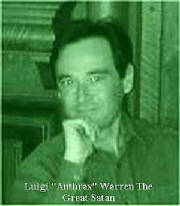
|
| "Do you know me?" |
"This is but one of my websites"
| The Man In The Iron Mask |
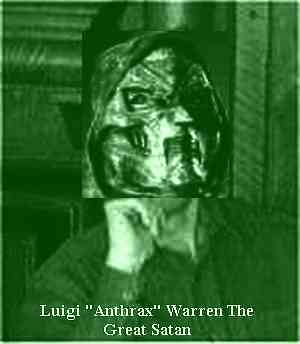
|
| Angry Loner With Scientific Knowledge |
'My background is software development
In recent years my professional focus has switched
from electronics to biology;
I'm now in the fourth year of a PhD in the subject.'
-Luigi Warren aka "The Great Satan"


__________________________________________________________

"The Rules of Civilization
Demand Reciprocity"
-"NativeNewYorker" aka
The Great Satan
The Great Satan
On www.Freerepublic.com
The Victims - What is the True Number of Victims of the Postal Anthrax Attack of 2001? Eighteen? "No,68 people"

|
| Bugs in the Mail |
____________________________________________________
".. postal workers have had to cope with a
new reality since the 2001 anthrax attacks.
"It's just never going to be the same,"
said Powell, of Capitol Heights.
"We're volunteers in terms of service,
but we didn't choose to put our lives on the line,
not as postal employees. We never thought that
would be a risk that we took."
Postal Workers
Negative Results But Very Real Fears
Mail Handlers Recall Brentwood Victims
By Debbi Wilgoren and Manny Fernandez
Washington Post Staff Writers
___________________________________________________________
The Anthrax Fumble
by MARC SIEGEL
[from the March 18, 2002 issue]
"...On October 16, microbiologists at the Army lab counted more than a billion spores in the Daschle envelope and
discovered the fine military grade of the powder, which should have alerted them right away to its potency. In a conference
call that day with the FBI and the CDC, the Army scientists described the powder as "going poof," an indication
that it could become airborne. Yet, according to the CDC's Cohen, the Army and FBI officials didn't express concern that this
could lead to the spread of the more deadly inhaled form of anthrax. In fact, Cohen said that the Army scientists, having
heard from FBI officials that the Daschle letter was supposedly well sealed, predicted limited spread--as they had with the
Brokaw letter. Army scientists, who are not accustomed to making public health proclamations, wrongly reassured the CDC without
sufficiently testing the spread potential of this dangerous anthrax.
The CDC, in turn, blindly passed the information to the post office, noting that there was no risk to postal employees
and that mail sorting equipment could be presumed safe...."
The Anthrax Fumble
"The truth is that postal workers belong to the politically invisible section of American society."
-BBC

|
| Joseph Curseen |
Source: Washington Post, October 26, 2001.
Two Men Who Were Just Doing Their Jobs
The Man Next Door: Joseph Curseen Jr. Pulled His Community Together
By Phil McCombs, Washington Post Staff Writer
Joseph P. Curseen Jr. was no whiner.
After feeling ill and passing out at Mass last Saturday afternoon, he told the rescue squad he was okay, and stayed to
receive Communion.
That night, as usual, Curseen, 47, reported for work at the big Brentwood postal facility in Northeast Washington -- but
by 2 a.m. he was again feeling so ill that he called his wife, Celestine, and went home early.
The next day his condition worsened. He was tired and nauseated. He was perspiring beads of sweat "as big as half
dollars," his wife later told a priest. She took him to Southern Maryland Hospital Center near their home in Clinton,
where he was diagnosed with stomach flu and sent home.
Early the next morning she brought him back to the emergency room. He was having trouble breathing.
Six hours later he was dead -- of inhalation anthrax.
Joe Curseen Jr., Celestine said, was a devoted, loving husband -- "caring, friendly, religious." Then, unable
to continue, she excused herself, saying she had to hang up the phone...."
Postal worker suspected he had anthrax
November 8, 2001 Posted: 1:58 PM EST (1858 GMT)
Morris: "They never let us know whether this thing was anthrax," he told a 911 dispatcher.
WASHINGTON (CNN) -- A postal worker who died of inhalation anthrax last month knew he had been exposed to a suspicious
letter and tried to tell postal officials, apparently to no avail.
In a 911 call placed just hours before his death October 21, Thomas Morris Jr. requested an ambulance and described symptoms
consistent with the inhalation form of the disease.
"My breathing is labored; my chest feels constricted," Morris said. "I am getting air, but I -- to get
up and walk and what have you -- it just feels like I'm going to pass out if I stay up too long."
Morris, 55, an employee of the Brentwood processing center in Washington, said a woman working near him found a letter
with powder in it October 13."
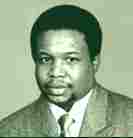
|
| Thomas Morris Jr |

In Memory Of....

You Know Kathy Nguyen
Kathy T. Nguyen. Do you know her? 61 years old. A Vietnamese immigrant who entered the country in San Diego on May 4,
1975. A refugee. Known relatives all killed in Vietnam. Later, she moved to New York. Alone in the Bronx. Maybe a Yankee fan.
All of America wishes they knew her better now. Or at least the epidemiologists do. But the truth is, each and every one
of us in the community know of one, if not dozens, or hundreds just like Kathy T. Nguyen.
We may even be related to them. They just didn’t die of anthrax.
---------------------------------------------------
Widow who died of anthrax laid to rest
Probe into baffling case continues
OXFORD, Connecticut (CNN) -- Family and friends of an elderly Connecticut widow who died of anthrax gathered Saturday
to say their final farewells, as investigators continued puzzling over how she contracted the deadly illness."
"Ottilie Lundgren, 94, became the nation's fifth anthrax fatality since letters laced with the deadly bacteria began
turning up in the mail last month."



|
| Norma Wallace |
Deadly Letters
"On October 14, 2001, a 56-year-old postal worker for New Jersey's Hamilton regional mail processing plant, Norma
Wallace, was treated at the hospital for flu-like symptoms accompanied with chest pains. Following clinical tests, it was
discovered that Wallace had contracted inhalation anthrax. It was believed that she contracted the disease while on duty,
sometime on or around October 9. She was treated with antibiotics and, after almost a month in the hospital, she was released."

|
| David Hose |
On Oct. 24, 2001, David Hose was admitted to WMC for inhalation anthrax after handling a contaminated letter at his supervising
position for a diplomatic mail facility in Sterling. The letter he handled was addressed to Sen. Patrick J. Leahy, D-Vt.,
but was delivered to the Sterling facility because of an incorrect ZIP code.
"Over the next few days, Mr Hose and his doctors wrestled with his illness. He had a dangerously high fever, despite
up to seven different intravenous lines pumping drugs and fluids into him.
His heart beat irregularly and at double its normal rate, his blood pressure soared and he contracted pneumonia. A pint
and a half of fluid had to be drained from his lungs, and his lymph glands swelled to the size of large lemons.
He developed two severe rashes, and had such a high fever that he was placed on a special pad, cooled by liquid circulating
within it. "I thought I'd die with the cold," he said. After a week he turned the corner, however, and was eventually
allowed home.
Whoever sent the letter had to be "sick or mentally ill", said Mr Hose, adding that he bore no malice towards
them. "There's no point in carrying malice around," he said. "I lived through it - and if I was dead I'd have
no malice anyway."
Mr Hose does not know how long it will be before he returns to work and, although he did not say so, he could probably
use a little extra money.
Colin Powell, the secretary of state, telephoned to wish him well before he was discharged from hospital. But Mr Hose
is not a federal employee: he works for an independent contractor and, as such, his experience is being treated like any other
industrial illness.
He is at home on a reduced income and now wants to know if the funds set up for victims of the September 11 attacks can
cover anthrax cases too. "It is time to find out where I stand," he says."
Baltimore Sun, January 9, 2002.
Testing may not detect anthrax
Doctors blame spores for postal inspector's mysterious illness; No other 'valid explanation'
By Scott Shane, Sun Staff
A 37-year-old Maryland postal inspector who handled anthrax-contaminated air filters at Washington's Brentwood mail-sorting
center in October has been severely ill ever since with symptoms resembling those of inhalation anthrax, including fever and
chest pain.
But because medical tests have never detected anthrax bacteria or antibodies in his blood, the federal Centers for Disease
Control and Prevention has declined to classify his illness as anthrax.
Nevertheless, the doctors who have cared for him at Sinai Hospital in Baltimore for more than two months say in a medical
journal article to be published today that they believe anthrax spores he inhaled 12 weeks ago are to blame for his illness.
The mysterious case of William R. Paliscak Jr. raises the troubling possibility that officials may not have fully recognized
the extent of the wave of anthrax cases linked to letters sent last fall by an unidentified bioterrorist...."
Then And Now -
Shower of Anthrax
Inspector may be fifth anthrax victim:-
ANNAPOLIS, Md. | June 07, 2005 7:11:27 PM IST
An inspector looking into Washington's anthrax attacks contracted anthrax-like poisoning symptoms, but officials refuse
to list him among those attacked.
Two people were killed and two others were sickened in the fall of 2001 because of anthrax traced to letters to two U.S.
senators. Postal Inspector Bill Paliscak removed the filter above the machine that sorted the letters near where the two dead
men had worked, The New York Times reported Tuesday.
The dust that drifted down contained anthrax spores. Four days later Paliscak became ill with anthrax-like symptoms. He's
been in and out of the hospital since, the Times said, and his medical bills total more than $800,000. But he's not considered
a victim of the anthrax attack because blood tests never showed anthrax-related bacteria and antibodies.
Medical officials, including the Centers for Disease Control, say a proper diagnosis cannot be made without laboratory
confirmation.
While the Department of Labor determined Paliscak's illness was work-related, and he receives workmen's compensation,
Paliscak and his personal doctors are frustrated by the lack of a formal anthrax diagnosis. One doctor accused the CDC of
having it's head in the sand about the case, the Times said.
(UPI)
"The variety of symptoms Mr. Paliscak suffers would be enough for a hospital ward full of patients. His limbs swell with fluid,
pushing his previous weight of 185 pounds as high as 310. His hormone-producing glands have shut down, setting off a cascade
of secondary effects. He experiences spells of overwhelming fatigue that can last for several days. His legs regularly are
gripped by painful convulsions, the thigh muscles shaking as he struggles to hold them still...."
Anthrax Victims Relief Legislation Introduced In Senate 2003. So, where's the relief?
"Mr. President, 2 years ago, a letter containing about 1 gram of highly concentrated anthrax was opened in my office
in the Hart Senate Office Building. Potentially deadly anthrax letters were also mailed, apparently by the same person or
persons, to my dear friend and colleague, Senator PATRICK LEAHY, and to several news organizations. Two years later, all of
those crimes remain unsolved.
The anthrax attack on the Senate remains the largest bioterrorism attack ever on U.S. soil. Here in the Senate my staff
and members of Senator Feingold's staff were exposed to up to 3,000 times the lethal dose of anthrax.
The entire Hart Senate Office Building was closed for 3 months while scientists searched for a way to do something
that had never been done before: To reclaim a building that had been badly contaminated by anthrax...."
- Mr. DASCHLE
"Thomas Morris and Joseph Curseen worked for the U.S. Postal Service. They were decent, hard-working men who pushed
themselves and continued to go to work and church even as anthrax infections were killing them. They and Robert Stevens, Kathy
Nguyen, and Ottilie Lundgren all lost their lives in the anthrax attacks.
Their families have suffered a devastating blow. This bill would allow them to receive some small compensation for their
losses without having to suffer through the additional trauma and long delays associated with a lawsuit."
-Senator Tom Daschle
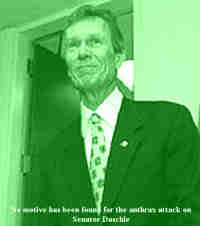

Anthrax problems linger in survivors ©Washington Post April 21, 2002 WASHINGTON -- Six months after inhaling anthrax spores,
several of the mail workers who survived the deadly disease have yet to make a full recovery and are experiencing serious
fatigue and memory loss. _________________________________________________
| "Anthrax victims relief - don't make me laugh" |

|
| "Where's the relief for us unemployed microbiologists?Let the cry babies eat baby powder! |
_________________________________________________________
"Over a year and a half since the mailings of the anthrax letters and the Amerithrax investigation into the first
fatal biological attack on Americans appears to have slipped from the back burner off of the stove.
I say, "appears", as we are not privy to the investigative machinations and, perhaps, that's how it should be.
Nevertheless, white powder "hoaxes' continue to plague communities, terrifying recipients, tying up police and hazmat
teams from Seattle to the Senate to The U.S. Consulate's visa processing office in Rome.
Reporting on these events has, for the most part, been scant of substitutive details, such as how envelopes are addressed
or, more importantly, where they were postmarked.
Rather then rest on his laurels, perhaps the Anthrax Mailer is keeping himself in minor league headlines"
-Protection Technologist 2002
__________________________________________________________
Trial Runs:
"There is another hoax anthrax attack. A handful of envelopes with almost identical messages are sent to a combination
of media and government targets including The Washington Post, NBC's Atlanta office, a post office in Columbus, Georgia (next
to Fort Benning, an Army base), and the Old Executive Office Building in Washington. The letters contained fake anthrax powder."
February 1999 post office in Columbus, Georgia. Anthrax Hoax
September/October 2001 post office in Trenton New Jersey, Anthrax
February 1999 Old Executive Office Building in Washington, DC. Anthrax Hoax
September/October 2001 Senate Office Building in Washington DC. Anthrax
February 1999 NBC news offices in Atlanta, Georgia Anthrax Hoax
September/October 2001 NBC news offices in New York City. Anthrax
February 1999 The Washington Post offices in Washington, DC. Anthrax Hoax
September/October 2001 The New York Post Offices in New York City. Anthrax
Practice Makes Perfect-
Any questions?
__________________________________________________ And then there's B'nai B'rith 1997 - "B'nai B'rith Execs: '97 'Hoax' Was
Anthrax"
2001
B'nai B'rith Execs: '97 'Hoax' Was Anthrax
November 2, 2001: B'nai B'rith executives in Washington DC reported that the 1997 Passover Anthrax 'Hoax'; a petri dish
containing red slurry labled "anthracks", sent to B'nai B'rith, a Jewish social organization in DC, and subsequently
reported to have contained Bacillus cereus, an anthrax look-alike, actually was Bacillus anthracis - anthrax, according to
the FBI.
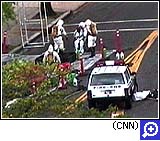
April 24, 1997
A package containing a petri dish mislabeled anthracks is received at the B'nai B'rith headquarters in Washington,
DC. The choice of B'nai B'rith probably was meant to suggest Arab terrorists, because the building had once been the target
of an assault by Muslim gunmen. The dish did not contain anthrax but did contain bacillus cereus, a very close, non-toxic
cousin of anthrax used by the US Defense Department. There are similarities to the later real anthrax attacks (see October
4, 2001), such as the misspelling penacilin;. In July 2002, B'nai B'rith claims the FBI still hasn't asked them about this
hoax anthrax attack. [New York Times 7/12/02]
___________________________________________________________
Whodunit?
Foreign vs Domestic
The domestic terrorist theory has been receiving wider attention in recent days and sparked debate among experts not affiliated
with the investigation.
Robert Ressler, a former supervisor of the FBI's Behavioral Science Unit, believes agents should be looking for a home-grown
bioterrorist.
"It is probably a person working in some lab somewhere," said Ressler. "And the hostility, the mental dysfunction,
was present, but the triggering event (on Sept. 11) is what I think caused the person to do this."
"It appears that it is a domestic person or group; that is the prevailing thought," a ranking law enforcement source
said."
December 2, 2001
New York Times
A NATION CHALLENGED: THE GERM ATTACKS;
Inquiry Includes Possibility of Killer From a U.S. Lab
By WILLIAM J. BROAD and JUDITH MILLER
... Some see the attacker as home-grown -- perhaps a disaffected scientist or a militia group -- while others discern
a conspiracy by a state like Iraq or a foreign terrorist group. In the United States, there are probably scores of laboratories
and contractors and hundreds of people who have access to essential anthrax ingredients and recipes. The insider avenue of
inquiry is consistent with the official profile of the suspect, released on Nov. 9 by the F.B.I. The profile describes a man
with a strong interest in science who is comfortable working with hazardous material and has "access to a source of anthrax
and possesses knowledge and expertise to refine it."
Separately, a private expert in biological weapons, Barbara Hatch Rosenberg, has recently published a paper contending
that a government insider, or someone in contact with an insider, is behind the attacks. Though not an expert on criminal
profiling, Dr. Rosenberg, a molecular biologist at the State University of New York, has testified on biological weapons before
Congress, advised Bill Clinton when he was president and made addresses to international arms control meetings, including
one a few days ago in Geneva.
Law enforcement officials said Dr. Rosenberg's assertion might turn out to be well founded, though they emphasized that
the investigation was still broadly based. One official (unnamed) close to the federal investigation called the Rosenberg
theory "the most likely hypothesis." Referring to her paper, the official said, "I might not have put it so
strongly, but it's definitely reasonable."
Other analysts, including some scientists and experts in germ weapons, expressed more skepticism of the theory that it
had to be an insider, contending that the skills and knowledge needed to produce the type of anthrax in this attack were widely
available. The paper laying out Dr. Rosenberg's thesis was distributed on Thursday by the Stockholm International Peace Research
Institute, an arms control group. Dr. Rosenberg, who is chairwoman of an arms control panel at the Federation of American
Scientists, a private group in Washington, has argued repeatedly that states, not individuals, tend to have the wherewithal
to make advanced biological weapons. International treaties that prohibit that work, she believes, are thus critical. Dr.
Rosenberg contends that the Ames strain probably did not originate in 1980 or 1981, as is often asserted, but arose decades
earlier and was used in the secret American program to make biological weapons.
She agrees with a conclusion, reached by some experts knowledgeable about the investigation, that the anthrax powder distributed
in the attacks by letter was treated in a sophisticated manner so it floated easily, as was done in the old American offensive
weapons program, unlike Colonel Friedlander's defensive program, which uses the wet anthrax. "All the available information,"
she said, "is consistent with a U.S. government lab as the source, either of the anthrax itself or of the recipe for
the U.S. weaponization process."
Dr. Rosenberg contended that the anthrax used in the attacks either originated in the weapons program itself or was made
by someone who had learned the recipe. The killer, Dr. Rosenberg concludes, is "an American microbiologist who had, or
once had, access to weaponized anthrax in a U.S. government lab, or had been taught by a U.S. defense expert. (early peak
into the story Wm. Patrick taught Hatfill?) Perhaps he had a vial or two in his basement as a keepsake." The paper, "A
Compilation of Evidence and Comments on the Source of the Mailed Anthrax," dated Nov. 29, is based on interviews with
federal and private experts, published reports and scientific articles.
Few details of the insider investigation are known. But federal agents are already interrogating people in the military establishment
that replaced the old program for making biological weapons. The facilities for that effort, in western Maryland, are major
repositories of the Ames strain of anthrax, the particularly virulent form that federal officials have identified as the type
used in the attacks that killed five people. Col. Arthur M. Friedlander, the senior research scientist at the Army's biodefense
laboratory at Fort Detrick, Md., said in an interview on Friday that officials there were cooperating with federal investigators.
"They've asked us about personnel who had access," he said, speaking reluctantly. "They didn't talk to me about
my personal experience," said Colonel Friedlander, a physician and leading anthrax expert. "They asked me about
other personnel."
He went on to dismiss the insider idea as improbable. Whoever made the killer anthrax, he said, "clearly knew what
they were doing." "But to make the leap that this came out of a government lab is somewhat large," he added.
He emphasized that no one in his organization, the Army Medical Research Institute of Infectious Diseases, a leader in developing
germ defenses, even knew how to make dry anthrax, as was found in the letters used in the attacks. Instead, he said, scientists
there used wet anthrax, which is far easier to make. It is used in developing vaccines and testing their effectiveness. "We
haven't had an offensive program for a long time," Colonel Friedlander said. Nobody at the Army's laboratory, he added,
"has that kind of expertise."
... Some see the attacker as home-grown -- perhaps a disaffected scientist or a militia group -- while others discern
a conspiracy by a state like Iraq or a foreign terrorist group. In the United States, there are probably scores of laboratories
and contractors and hundreds of people who have access to essential anthrax ingredients and recipes. The insider avenue of
inquiry is consistent with the official profile of the suspect, released on Nov. 9 by the F.B.I. The profile describes a man
with a strong interest in science who is comfortable working with hazardous material and has "access to a source of anthrax
and possesses knowledge and expertise to refine it."
...At Harvard, Ms. Stern also finds some logic in suspecting the media attacks may have a domestic origin.
"Right-wing extremists," she said, "are obsessed with biological warfare."
She has studied a former member of a neo-Nazi group who in 1997 was arrested -- though the parole- violation charges were
later dismissed -- for claiming, falsely, that he had "military-grade" anthrax in his possession....
Some terrorism specialists outside law enforcement lean toward the example of Theodore Kaczynski, the Unabomber, who built
intricate bombs in his Montana hideaway and escaped detection for years.
They theorize that an angry loner with the requisite scientific expertise may have decided to piggyback on the horror
of the Sept. 11 attacks. "Any terrorist worth the name would realize it was a good time to strike," said Harvard
lecturer Jessica Stern. "Right-wing domestic extremists want to undermine American citizens' faith in the government.
They want to prove to the American people that the government isn't serving their interests."
"Investigators are searching for a pattern in the attacks, aware that the extreme right has long held much of the
national media in contempt.
Letters containing anthrax bacteria reached the highest- ranking Democrat in Washington and the New York offices of NBC,
ABC and CBS, as well as the New York Post and a Florida-based tabloid, the Sun. FBI Director Robert S. Mueller III said Friday
that the bureau is not tilting either way in its suspicions."
October 15, 2001
New York Times
In Anthrax Probe, Questions of Skill, Motive;
Some Terrorism Specialists Suspect an Angry Loner With Scientific Knowledge
Analysts who monitor militias and political movements on America's far right doubt that any known domestic group was capable
of launching the deadly anthrax that has left four people dead and at least 12 others sickened. "American groups on the
right tend to be small and poorly organized," said Mark Pitcavage, who directs fact-finding for the Anti-Defamation League.
"If it turns out to be a domestic extremist source, the odds are more likely it would be an individual or a small group
of individuals, rather than an organization."
Senior officials at the FBI and CIA have told reporters privately that they believe the anthrax bacteria likely came
from a U.S. source. That contention, challenged by others who suspect an overseas conspiracy, leaves open a very large question:
Who in the United States had the skill and the motivation to wield a germ as a weapon?
Some terrorism specialists outside law enforcement lean toward the example of Theodore Kaczynski, the Unabomber, who built
intricate bombs in his Montana hideaway and escaped detection for years.
They theorize that an angry loner with the requisite scientific expertise may have decided to piggyback on the horror
of the Sept. 11 attacks.
"Any terrorist worth the name would realize it was a good time to strike," said Harvard lecturer Jessica Stern.
"Right-wing domestic extremists want to undermine American citizens' faith in the government. They want to prove
to the American people that the government isn't serving their interests."
___________________________________________________________
Investigators are searching for a pattern in the attacks, aware that the extreme right has long held much of the national
media in contempt. Letters containing anthrax bacteria reached the highest- ranking Democrat in Washington and the New York
offices of NBC, ABC and CBS, as well as the New York Post and a Florida-based tabloid, the Sun. FBI Director Robert S. Mueller
III said Friday that the bureau is not tilting either way in its suspicions.
In recent days, high-ranking bureau and CIA officials have said the composition of the anthrax-laden powder and the "totality"
of the evidence convinced them the conspiracy originated in the United States, either among American militants or foreign-born
opponents of the United States and Israel. (Ie, could be AQ, Hamas, whomever. Letters were mailed in New Jersey) With little
evidence in hand, federal authorities are still considering the possibility the attack was undertaken by a militant Islamic
cell or individual connected to, or inspired by, the Sept. 11 plotters.
... Some see the attacker as home-grown -- perhaps a disaffected scientist or a militia group -- while others discern a conspiracy
by a state like Iraq or a foreign terrorist group. In the United States, there are probably scores of laboratories and contractors
and hundreds of people who have access to essential anthrax ingredients and recipes. The insider avenue of inquiry is consistent
with the official profile of the suspect, released on Nov. 9 by the F.B.I. The profile describes a man with a strong interest
in science who is comfortable working with hazardous material and has "access to a source of anthrax and possesses knowledge
and expertise to refine it."

|
| HOMEGROWN |
"ARE YOU AFRAID?"
"It's been my hunch for days now," he said, "that [the source is] some angry person perhaps living in the
New Jersey area who has been an employee of a major pharmaceutical company
-CNBC's Hardball show, Chris Mathews
Bingo!

___________________________________________________________
"Franz politely said Mathews didn't know what he was talking about."
Anthrax Plot Against Liberals?
By Reed Irvine and Cliff Kincaid | November 8, 2001
On CNBC's Hardball show, Chris Mathews suggested the source
was someone who hates liberals..
.. counter terrorism specialist suspected the anthrax terrorism was
domestic because one of the letters went to Daschle, "who's on the left.
The federal government's handling of the anthrax controversy
seems like the Keystone Cops. The most serious aspect was the failure to immediately test postal workers, two of whom
died of anthrax exposure.
Media coverage has followed confusing government statements.
First, the anthrax in Senator Tom Daschle's office was said to be "weapons-grade." Then a government scientist
said it was "common-variety" anthrax. Then we were told it was, in fact, weapons-grade.
The letters were discovered after the terror attacks of September 11th. Some of the letters say, "Death to America,"
and have praise for Allah. It seems obvious to some that radical Muslims wrote the poison letters. The letters are written
or printed in such a way as to suggest they are the work of someone who has just learned his letters and the language. That,
too, suggests a foreigner who hasn't been in the U.S. very long.
But what seems obvious to some doesn't make sense to others. Gary Brown, described as a retired Air Force counter terrorism
specialist, told the Washington Post that he suspected the anthrax terrorism was domestic because, he said, one of the letters
went to Daschle, "who's on the left. If it's a home-grown militia effort,
Daschle's a likely target." But Daschle has never been a major target of the far right-wing. He's never been seen
as a major left-wing figure. One might expect the militia send a letter to an official of the Bureau of Alcohol, Tobacco and
Firearms.
Iraq has been suggested as a possible source, and this makes a lot of sense. Iraq has concealed its hand in past terrorist
incidents, such as the 1993 World Trade Center bombing. But Iraq's foreign minister and top scientist assured Lesley Stahl
on 60 Minutes that they would
never do such a thing.
Following the lead of that so-called expert quoted in the Post, some of the talking heads in the media have started suggesting
that right-wingers are the source of the anthrax.
On CNBC's Hardball show, Chris Mathews suggested the source
was someone who hates liberals working at a plant making underarm deodorant.
"It's been my hunch for days now," he said, "that [the source is] some angry person perhaps living in the
New Jersey area who has been an employee of a major pharmaceutical company that may work with aerosol sprays for underarm
deodorants or whatever.
Would that kind of engineer have the capability – just because he didn't like the country, didn't like liberals
or media people, to produce this kind of anthrax and put it in an envelope?"
His guest was David Franz, the vice president of chemical and biological defenses at the Southern Research Institute and
a former commander at the Army's germ defense lab at Ft. Detrick,
Maryland. Franz politely said Mathews didn't know what he was talking about.
He explained, "He'd have to learn a lot more than just what he knew working with underarm aerosol sprays. Those are
chemicals, and here we're dealing with living things. We're dealing with a spore that you have to keep alive.
" One doesn't know whether to laugh or cry at Mathews' pathetic attempt to blame conservatives for the anthrax terrorism.
Reed Irvine is the Publisher and Cliff Kincaid is the Editor of the
AIM Report.
Arab scientists recount hostility and harassment
at military anthrax lab
Seattle Times
19 December 2001
"...The third plaintiff who was laid off from Fort Detrick,
Jordanian-born Dr. Kulthoum Mereish, was commissioned a captain
in the U.S. Army Medical Corps and began researching
biological-threat agents at Fort Detrick in 1986. She alleged in the
affidavit accompanying her lawsuit that Franz exhibited "a bigotry
toward foreigners" and refused to confront the
"camel club."
***
Supervisor approached
Assaad said he approached his supervisor, Col. David Franz, with his
concerns, but Franz "kicked me out of his office and slammed the
door in my face, because he didn't want to talk about it. I just
wanted it to stop."
He and other scientists allege that ethnic discrimination was
tolerated, and even practiced, by the lab's former commander. ..."
Col. David R. Franz:
"A former commander of Fort Detrick, Col. David Franz, said, "A lot of good has come from it . . . five people
have died, but we've put about $6 billion in our budget . . ."
But for the families of the five people who died, it is cold comfort."
(ABC News, 4/4/02).
___________________________________________________________
From Whence The Seeds? -

"I don't know why everybody is so obsessed
with finding someone other than Saddam to pin this on. "
-The Great Satan
Angry Loner With Scientific Knowledge

Anthrax Missing From Army Lab
"Shenanigans have been going on," declares one internal Army memo about the labs at ground zero of the biodefense
world: Usamriid, the acronym for the U.S. Army Medical Research Institute of Infectious Diseases, based at Fort Detrick, Md.
The 400 pages of documents, which I've obtained and which were described by The Hartford Courant earlier this year, quote
a newly arrived officer named Michael Langford as saying that he found "little or no organization," "little
or no accountability," "a very lax and unorganized system" and signs of covert work and cover-ups.
Mr. Langford requested an inventory of pathogens acquired in 1991. The resulting memo shows that 62 samples had vanished,
including Ebola, hantavirus, anthrax, S.I.V. (the monkey version of the virus that causes AIDS), and several described only
as "unknown."
Nicholas Kristoff
Nre York Times

 January 20, 2002 By JACK DOLAN And DAVE ALTIMARI, Courant Staff Writers Lab specimens of anthrax spores, Ebola virus and other
pathogens disappeared from the Army's biological warfare research facility in the early 1990s, during a turbulent perio of
labor complaints and recriminations among rival scientists there, documents from an internal Army inquiry show. The 1992 inquiry
also found evidence that someone was secretly entering a lab late at night to conduct unauthorized research, apparently involving
anthrax. A numerical counter on a piece of lab equipment had been rolled back to hide work done by the mystery researcher,
who left the misspelled label "antrax" in the machine's electronic memory, according to the documents obtained by The Courant.
"A former Army official said the fact that vials of anthrax were missing was public knowledge back in 1991, but both
McDermott and Assaad disagree.
"I knew they were missing, but it was very hush, hush," Assaad said.
| Anthrax Source |

|
| 1991 Ft Detrick USAMRIID The Camel Club |

|
| U.S. Army Medical Research Institute of Infectious Diseases USAMRIIDBizarre, disjointed and juvenile |
"Bizarre, disjointed and juvenile" Days before the anthrax attacks became known, Dr. Ayaad Assaad sat terrified in a vault-like
room at an FBI field office in Washington, D.C. The walls were gray and windowless. The door was locked. It was Oct. 3. Assaad,
an Egyptian-born research scientist laid off in 1997 from the Army's biodefense lab at Fort Detrick, Md., was handed an anonymous
letter describing him as "a potential terrorist" with a grudge against the United States and the knowledge to wage biological
warfare against his adopted country. "I was so angry when I read the letter, I broke out in tears," Assaad recalled during
a recent interview. "That people could be so evil." After a brief interview, the FBI let Assaad go and assured him that they
believed the letter was a cruel hoax. But for Assaad, the incident was another in a series of humiliations he traces to a
decade-long workplace dispute at the Fort Detrick lab. He and other scientists allege that ethnic discrimination was tolerated,
and even practiced, by the lab's former commander. A cadre of coworkers wrote a crude poem denigrating Arab Americans, passed
around an obscene rubber camel and lampooned Assaad's language skills. The locker-room antics in the early 1990s preceded
a series of downsizings, some acrimonious, that saw the lab's staff reduced by 30 percent. Along the way, the court record
suggests, the Fort Detrick facility became a workplace where "toxic" described more than just the anthrax and other deadly
pathogens handled by its 100 scientists. It also characterized a dysfunctional, at times hostile, atmosphere that had the
potential to create the type of disaffected biowarfare scientist that some experts suspect is behind the anthrax attacks.
Neither Assaad nor any other scientist named in the court documents has been linked to the attacks, and most say they have
not even been questioned by the FBI. A Fort Detrick spokesman said yesterday that investigators are seeking to question current
and former employees of the lab, as well as other government facilities that had access to the same strain of anthrax...."
"Assaad claims in the suit that scientists and high-ranking Army officers formed a "camel club," a derogatory
reference to his Egyptian background."

Rhyme of the Ancient Camellier
"Ayaad Assaad was the start,
with a reputation for not having heart
A 'skimmer' without equal
We hope there's no sequel
In his honor we created this beast
It represents life lower than yeast
Whoever is voted this sucker,
you can't duck her,
You must accept blame,
And bear all the shame
Unlike Assaad,
that first motherfucker"
***
Well it's time for the camel to pass
So let's all reach and raise up a glass.
Let's give'm the credit,
the one who will get it
the poor bastard we're gonna harass."
-The Camel Club
Ft Detrick circa 1991
FROM: Fort Detrick's anthrax mystery
Who tried to frame Dr. Ayaad Assaad, a former biowarfare researcher at the Army lab? Was it the same person responsible
for last fall's anthrax mail terrorism?
- - - - - - - - - - - -
By Laura Rozen
Salon
__________________________________________________________
"the poor bastard we're gonna harass." On the night of March 12, Ayaad Assaad received a call from a person representing himself
as a Louisiana F.B.I. agent. The caller demanded to know if Assaad had been told who wrote the Quantico letter. To prove his
credentials, the caller rattled off personal information from as far back as Assaad's Egyptian high school -- the Arabic name
of which he pronounced correctly. Assaad believes he recognized the caller's source of information: he was likely reading
from Assaad's confidential SF-171, a U.S.-government employment application form that had been on file at USAMRIID. Frightened,
Dr. Assaad hung up, then called me at home at 10 P.M. to tell me of the incident. I assured him the call was fraudulent. The
F.B.I. does not conduct its business in that way." -Don Foster
| "Everyone was a Camel Club Member" |

|
| "Besides - I'm no poet" |
| "Do you know me?" |

|
| "Me neither"/ |
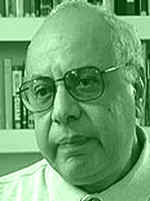
|
| Dr Ayaad Assaad |
'The FBI won't release an anonymous letter, which in the days before the 2001 fatal anthrax mailings, accused an Egyptian-born
scientist of plotting biowarfare against the United States, saying it would divulge secret sources in the continuing investigation.
In a July 7 note citing the sources, the FBI denied Ayaad Assaad, the letter's subject, access to the evidence. Mr. Assaad
said he's convinced it is linked to a person or a group responsible for the anthrax mailings that killed five persons. "They
know damn well that this letter is connected to the anthrax sender," he said, adding that the FBI's refusal to provide a copy
suggests "they're trying to protect whoever sent it."
"Whoever sent the anthrax letters did this to divert
attention," Assaad said. "They knew the attacks
would be eventually traced back to USAMRIID,
and they used me as a scapegoat.
"In an interview yesterday, Assaad repeated his
assertion that anthrax spores in dry, powdered
form were produced as a byproduct of research at
, based on his nearly 10 years there, that the
anthrax letters will eventually be connected to the lab.
Those suspicions were strengthened, he said, when
he learned that someone had anonymously written
the FBI in late September -- days before the first
anthrax cases were reported -- warning that
Assaad was a "potential bioterrorist."
Rosemary McDermott, Assaad's lawyer, said she
met with FBI agents on Oct. 3. They told her the
letter was a hoax, she said. McDermott and
Assaad noted however, that the public was not
aware of the anthrax attacks until officials
disclosed in early October that a photo editor for a
Florida tabloid newspaper was suffering from the
disease and had been admitted to a hospital Oct. 2.
"Whoever sent the anthrax letters did this to divert
attention," Assaad said.
"They knew the attacks would be eventually traced back to USAMRIID, and they used me as a scapegoat.
Who better than an Arab American scientist who used to work
there?"
Source: Washington Post, January 22, 2002.
Our minds are designed to kill. It's part of human nature.
"Indeed, I believe that there is nothing wrong with having such a capacity, knowing how violent to be in any prescribed situation
is the key. I guess that is how the term "overkill" was arrived at. When the situation warrants I can assure you that I can
be very violent. Libs and commies should take close notice of that! ;)"
23 posted on 05/29/2005 8:47:14 AM PDT by Camel Joe (Proud Uncle of a Fine Young Marine)
Since Oct 8, 2002
http://www.freerepublic.com/~cameljoe/

|
| "Joe Camel" Freerepublic.com |
___________________________________________________________
The anthrax spores mailed to Senators Thomas Daschle (D-- SD) and Patrick Leahy (D--VT) in the fall of 2001 represented
the state of the art in bioweapons refinement, revealing telltale clues about the source.
One group, comprised mostly of microbiologists and molecular biologists, argues that this material could have been a
do-it-yourself job, made by someone knowledgeable but with run-of-the-mill lab equipment on a modest budget. This contingent
includes one well-known bioweaponeer, Ken Alibek, who defected from Russia to the United States in 1992.
Dr. Rosenberg contended that the anthrax used in the attacks either originated in the weapons program itself or was made by
someone who had learned the recipe. The killer, Dr. Rosenberg concludes, is "an American microbiologist who had, or once
had, access to weaponized anthrax in a U.S. government lab, or had been taught by a U.S. defense expert.
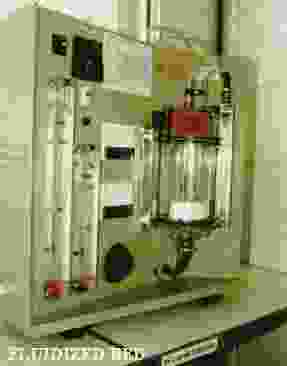
THE WEAPONIZATION OF A N T H R A X
THE WEAPONIZATION OF A N T H R A X
Anthrax spores are very stable resisting sunlight, heat, and disinfectants and thus can persist in the environment (e.g.,
soil or water)for years or even decades.
The spores resistant properties, says the U.S. Army, could be advantageous when choosing a biological weapon.Anthrax spores
also lend themselves to aerosolization,which is one reason why inhalation is considered the most likely route of anthrax transmission
in a bioterrorism attack.
At 2-6 microns in diameter, the spores are said to be the ideal sizefor impinging onhuman lower respiratory tract, thus optimizing
the chance for infection.
A primary means of attack might be the use of aerosol-delivery technologies over large outdoor areas.Weaponized anthrax, for
instance, could be dispensed as an aerosol cloud by a manned aircraftsuch as a crop duster or unmanned aircraft (drone) flying
along a line upwind of a target area, a moving vehicle traveling along city streets, a stationary spray device. It also
could be disseminated inside buildings via central air ventilation systems.Turning anthrax into a bioweapon presents a challenge
for terrorists, however. The manufacture and delivery of anthrax spores is madedifficult because the spores have a tendency
to clump.
The milling process used to weaponize anthrax, moreover, imparts a static charge, making small anthrax particles hard to
work with and increasing the likelihood that the spores, once released into the atmosphere, would soon bind to soil particles.
Thus the chances that anthrax spores might pose a secondary aerosolization danger following an initial release are viewed
as low.
| ANTHRAX POWDER - STATE OF THE ART |

|
THIS IS NEXT WE HAVE THIS ANTHRAX YOU CANNOT STOP US - Posted by The Great Satan to SJackson On News/Activism 10/16/2002 12:54:05
PM PDT · 6 of 7
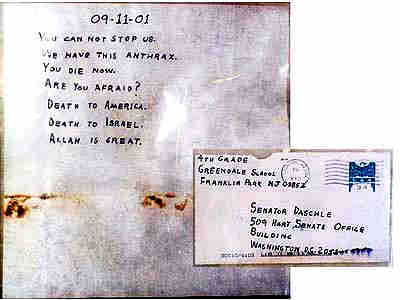
___________________________________________________________
ANTHRAX POWDER - STATE OF THE ART?
Science ^ | 11/27/2003 | Gary Matsumoto
When the anthrax mailers penned the message, "YOU CAN NOT STOP US. WE HAVE THIS ANTHRAX," the threat included
a chilling nuance that remains largely unrecognized. "ARE YOU AFRAID?" asked the attackers. "Yes," should
have been the answer, according to some biodefense experts, who think that the anthrax spores mailed to Senators Thomas Daschle
(D-- SD) and Patrick Leahy (D--VT) in the fall of 2001 represented the state of the art in bioweapons refinement, revealing
telltale clues about the source. This view is controversial, however, because others dispute the sophistication of the Senate
powder, and a schism now exists among scientists who analyzed it for the FBI.
One group, comprised mostly of microbiologists and molecular biologists, argues that this material could have been a do-it-yourself
job, made by someone knowledgeable but with run-of-the-mill lab equipment on a modest budget. This contingent includes one
well-known bioweaponeer, Ken Alibek, who defected from Russia to the United States in 1992.
The other faction thinks that the powder mailed to the Senate (widely reported to be more refined than the one mailed
to the TV networks in New York) was a diabolical advance in biological weapons technology. This diverse group includes scientists
who specialize in biodefense for the Pentagon and other federal agencies, private-sector scientists who make small particles
for use in pharmaceutical powders, and an electronics researcher, chemist Stuart Jacobsen of Texas.
Early in the investigation, the FBI appeared to endorse the latter view: that only a sophisticated lab could have produced
the material used in the Senate attack. This was the consensus among biodefense specialists working for the government and
the military. In May 2002, 16 of these scientists and physicians published a paper in the Journal of the American Medical
Association, describing the Senate anthrax powder as "weapons-grade" and exceptional: "high spore concentration,
uniform particle size, low electrostatic charge, treated to reduce clumping" (JAMA, 1 May 2002, p. 2237). Donald A. Henderson,
former assistant secretary for the Office of Public Health Preparedness at the Department of Health and Human Services, expressed
an almost grudging respect: "It just didn't have to be that good" to be lethal, he told Science.
As the investigation dragged on, however, its focus shifted. In a key disclosure, U. S. Attorney General John Ashcroft
revealed in August 2002 that Justice Department officials had fixed on one of 30 so-called "per sons of interest":
Steven J. Hatfill, a doctor and virologist who in 1997 conducted research with the Ebola virus at the U. S. Army Medical Research
Institute of Infectious Diseases in Fort Detrick, Maryland. (Hatfill has denied any involvement in the anthrax mailing.) Although
the FBI did not spell out its theory, this announcement and leaks to the media from federal investigators indicated that the
inquiry had embraced the idea that a lone operator or small group with limited resources could have produced the Senate anthrax
powder.
This premise now appears to have run its course. In September 2003, the FBI's Michael Mason admitted that the bureau failed
to reverse engineer a world-class anthrax powder like the Senate material and expressed regret that Hatfill had been called
a "person of interest." One of the costliest manhunts ever conducted by federal investigators appears to be stymied.
The FBI cannot or will not say whether the anthrax powder was foreign or domestic, expensively made or cheaply done, a professional
job or the handiwork of an amateur.
But the scientific data amassed so far should provide a wealth of information on the weapon's possible origins, say scientists
in the group with expertise in such powders. They argue that the most striking qualities of the Senate powder do not concern
the anthrax spores but the way they were processed-- specifically, how they were given an electrostatic charge and unusual
surface properties. If the Senate anthrax powder did in fact have these refinements, its manufacture required a unique combination
of factors: a strain that originated in the United States, arcane knowledge, and specialized facilities for production and
containment. And this raises the discomforting possibility that the powder was made in America, perhaps with the resources
of the U.S. government.
Charged questions
There is no debating that the Senate powder was exceptionally pure and highly concentrated. Nor is there any doubt that
it contained the Ames strain, one of the most virulent strains discovered. But what made it truly remarkable, according to
biodefense specialists, was its conversion into a cutting-edge aerosol.
That transformation had as much to do with chemistry and physics as with microbiology. Anthrax spores cling to one another
if they get too close; sticky chains of proteins and sugar molecules on their surfaces latch onto each other, drawn by van
der Waals forces that operate at a distance of a few tens of angstroms. Untreated spores clump into larger particles that
are too heavy to stay airborne or reach the narrowest passages in the lung.
To thwart this clumping, an earlier generation of biological weapons makers--operating out of Fort Detrick when it still
made weapons--experimented with ways to prevent the surfaces of germs from getting too close. For example, William C. Patrick
III, former chief of Fort Detrick's Product Development Division, pioneered the use of a dusty silica powder with nanometer-sized
particles added to nonlethal incapacitating agents such as Francisella tularensis, the cause of tularemia (but not Bacillus
anthracis, the cause of anthrax). "Otherwise," says Patrick, the powder was "very hard to disseminate."
In a separate research arena, pharmaceutical scientists in the 1990s began experimenting with adding electrostatic charges
to small particles in medicinal powders designed for inhalation. Adding a like charge of sufficient strength creates an electrostatic
field of up to a few centimeters, which makes particles repel one another, creating an "energetic" or self-dispersing
powder.
Biodefense scientists say they became aware that such an innovation could be ap plied to germ-warfare powders with deadly
effect, especially deadly because charged particles are more prone to lodge in the lung. Once in the lung, immune cells transport
the spores to lymph nodes, where the spores germinate and cause infection. The Senate anthrax spores carried like electrical
charges, and some experts believe that they were added deliberately to aid dispersal.
Was it a coincidence that this lethal innovation appeared in the anthrax spores sent to the Senate? Alibek thinks it is
possible. The Senate anthrax could have acquired a charge from friction as the envelopes passed through mail-sorting machines.
(Alibek also has speculated that the powders mailed to the Senate were more refined than those sent to the New York media
and may have come from a different production run.) But his theory raises a question: Why would only the Senate powder acquire
a charge from the sorting machines?
Jacobsen, a research chemist who coated sub--5-micrometer particles with silica while working on a program for the Defense
Advanced Research Projects Agency (DARYA), is skeptical of this idea. Jacobsen says that friction would add static electricity
only to surfaces: "If anything, the sorting machine's pinch rollers and the envelopes should get charged," he says,
"not the spores inside."
Glassy finish
More revealing than the electrostatic charge, some experts say, was a technique used to anchor silica nano-particles to
the surface of spores. About a year and a half ago, a laboratory analyzing the Senate anthrax spores for the FBI reported
the discovery of what appeared to be a chemical additive that improved the bond between the silica and the spores. U. S. intelligence
officers informed foreign biodefense officials that this additive was "polymerized glass." The officials who received
this briefing-- biowarfare specialists who work for the governments of two NATO countries-- said they had never heard of polymerized
glass before. This was not surprising. "Coupling agents" such as polymerized glass are not part of the usual tool
kit of scientists and engineers making powders designed for human inhalation. Also known as "sol gel" or "spin-on-glass,"
polymerized glass is "a silane or siloxane compound that's been dissolved in an alcohol- based solvent like ethanol,"
says Jacobsen. It leaves a thin glassy coating that helps bind the silica to particle surfaces.
Silica has been a staple in professionally engineered germ warfare powders for decades. (The Soviet Union added to its
powders resin and a silica dust called Aerosil–a formulation requiring high heat to create nanoparticles, says Alibek.
U. S. labs have tested an Aerosil variant called Cab-O-Sil, and declassified U. S. intelligence reports state that Iraq's
chemical and biological warfare labs imported tons of both Cab-O-Sil and Aerosil, also known as "solid smoke," in
the 1980s).
"If there's polymerized glass [in the Senate samples], it really narrows the field [of possible suspects],"
says Jacobsen, who has been following the anthrax investigations keenly. "Polymerized glasses are exotic materials, and
nanotechnology is something you just don't do in your basement."
By March 2002, federal investigators had lab results indicating that the Senate anthrax spores were treated with polymerized
glass, and stories began to appear in the media. CNN reported an "unusual coating" on the spores, and Newsweek referred
to a "chemical compound" that was "unknown to experts who have worked in the field for years." When Science
asked the FBI about the presence of polymerized glass in the Senate powder, an FBI spokesperson said the bureau "could
not comment on an ongoing investigation."
About-face
By the fall of 2002, the awe-inspiring anthrax of the previous spring had morphed into something decidedly less fearsome.
According to sources on Capitol Hill, FBI scientists now reported that there was "no additive" in the Senate anthrax
at all. Alibek said he examined electron micrographs of the anthrax spores sent to Senator Daschle and saw no silica. "But
I couldn't be absolutely sure," Alibek says, "because I only saw three to five of these electron micrographs."
Even the astonishingly uniform particle size of 1.5 to 3 micrometers, mentioned in 2001 by Senator Bill Frist (R-- TN), now
included whopping 100-micrometer agglomerates, according to the new FBI description recounted by Capitol Hill aides. The reversal
was so extreme that the former chief biological weapons inspector for the United Nations Special Commission, Richard Spertzel,
found it hard to accept. "No silica, big particles, manual milling," he says: "That's what they're saying now,
and that radically contradicts everything we were told during the first year of this investigation."
Military scientists did not back off their findings. The August/ October 2002 newsletter from the Armed Forces Institute
of Pathology (AFIP) reported that a mass spectrometry analysis found silica in the powder sent to Senator Daschle (The AFIP
Letter, August/ October 2002, p. 6). "This was a key component," said the institute's deputy director, Florabel
Mullick, in the AFIP newsletter. "Silica prevents the anthrax from aggregating, making it easier to aerosolize,"
she added. Frank Johnson, chief of AFIP's Chemical Pathology Division, corroborated this in an interview. "There was
silica there," said Johnson, "there was no mistaking it." Maj. Gen. John S. Parker, commander of the U. S.
Army Medical Research and Materiel Command at the time of the attacks, says he saw AFIP's lab reports. "There was a huge
silicon spike" consistent with the presence of silica, he says. "It peaked near the top of the screen."
Other agencies support this view today. For example, John Cicmanec, a scientist with the U. S. Environmental Protection
Agency, says the Department of Homeland Security confirmed to EPA that the perpetrators did, in fact, use silica to weaponize
the Senate anthrax spores. According to an abstract that Cicmanec will present at the annual meeting of the Society for Risk
Analysis next month, this weaponized form of anthrax is more than 500 times more lethal than untreated spores.
The contradictory military data compelled the FBI to do some explaining. Sources on Capitol Hill say that in an FBI background
briefing given in late 2002, Dwight Adams, one of the FBI's top- ranking scientists, suggested that the silica discovered
in the Senate anthrax was, in fact, silicon that occurred naturally in the organism's subsurface spore coats. To support his
thesis, Adams cited a 1980 paper published by the Journal of Bacteriology-- a paper that Matthew Meselson, a molecular biologist
at Harvard University, says he sent to the FBI. The authors reported that they found silicon, the element, in the spore coats
of a bacterium called B. cereus, a close cousin of anthrax.
In the 23 years since the Journal of Bacteriology published these data, however, no other laboratory has published a report
on significant amounts of silicon in the B. cereus spore coat, and many bacteriologists familiar with these data consider
them an anomaly. Even the authors suggested the finding might have been due to "contamination."
In December 2002, the FBI decided to test whether a high-grade anthrax powder resembling the one mailed to the Senate
could be made on a small budget, and without silica. To do this job, the bureau called upon Army scientists at Dugway Proving
Ground, a desolate Army test range in southwestern Utah. By February 2003, the scientists at Dugway had finished their work.
According to military sources with firsthand knowledge of this effort, the resulting powder "flew like penguins."
The experiment had failed. (Penguins can't fly.)
Military sources say that Dugway washed and centrifuged the material four times to create a pure spore preparation, then
dried it by solvent extraction and azeotropic distillation-- a process developed by the U. S. Chemical Corps at Fort Detrick
in the late 1950s. It is not a simple method, but someone familiar with it might be able to jury-rig a lab to get the job
done. As recently as 1996, Bill Patrick says he taught scientists at Dugway how to do this.
The FBI-Dugway effort produced a coarse powder. The spores--some dried under an infrared lamp and the others air-dried--stuck
together in little cakes, according to military sources, and then were sieved through "a fine steel mesh." The resulting
powder was placed into test tubes. When FBI officials arrived at Dugway to examine the results, a Dugway scientist shook one
of the tubes. Unlike the electrostatically charged Senate anthrax spores that floated freely, the Dugway spores fell to the
bottom of the test tube and stayed there. "That tells you the particles were too big," says Spertzel. "It confirms
what I've been saying all along: To make a good powder, you need an additive."
Close to home
One doesn't have to look very far to find a powder that more closely resembles the Senate anthrax. The U. S. Army's newest
batch of anthrax simulant is a closer match, made with B. globigii (BG) spores, which are similar to anthrax but nonlethal.
According to military sources, the Danish company Chris- Hansen spray-dried the spores (along with an unidentified "additive")
in Valby, a suburb of Copenhagen. Although the spore count varied somewhat from batch to batch, Chris-Hansen says that the
average concentration was 500 billion spores per gram, about 100 times more concentrated than the Army's old BG powder. Chris-Hansen
shipped the bulk material from Denmark to its New Berlin, Wisconsin, facility in 1996, where, according to Army instructions,
it mixed silica into the powder-- a product sold commercially under the name Sipernat D 13. Sipernat D 13 is made by Germany's
Degussa AG, the same company that makes Aerosil.
The initial Chris-Hansen production run wasn't exactly what the Army wanted, military sources say, so this batch of anthrax
simulant was further enhanced at Dugway Proving Ground. An official at Chris- Hansen, speaking on condition of anonymity,
says he doesn't know if the Army added an electrostatic charge or a coupling agent to the powder, and the Army won't discuss
it. But unlike the powder that Dugway reverse engineered earlier this year, the most recent batch of simulant-- according
to military sources-- has great "hang time."
A government scientist who had a sample of the Army's anthrax simulant described it for Science: When he shook a test
tube filled with it, a dense fog of particles swirled to the top in roiling eddies. After 10 minutes, the powder still hadn't
settled. This scientist observed two other marked similarities with the Senate material: "There appears to be a lot of
static charge," he said. When he suspended the preparation in water, he saw mostly "single spores." When Canadian
military scientists used this silica- laced simulant in 2001 to assess the risk from anthrax spores delivered by letter, the
aerosol behaved like the one that would later contaminate Senator Daschle's office with real anthrax spores; the weaponized
BG particles spread across a 50-cubic-meter room in less than 2 minutes.
This new batch of "energetic" simulant was light-years beyond the old U. S. weapon in its refinement, experts
say. Divulging the specifications of the weapon, the last foreman in charge of drying and milling anthrax spores at Fort Detrick,
Donald Schattenberg, told Science that the old U. S. anthrax powder contained no additives. "We didn't use silica or
bentonite" (a clay that contains a high percentage of fine- particulate silica), says Schattenberg. "We made little
freeze-dried pellets of anthrax," he says, "then we ground them down with a high-speed colloid mill." The resulting
powder contained growth media residue (called "menstruum") and vegetative cells, making it less concentrated, according
to William P. Walter, who says he worked on every batch of anthrax spores ever produced at Fort Detrick. This extraneous material
accounted for a significant amount of the powder's volume and mass.
Orley Bourland, who once managed the entire operation, says the old weapon had no electrostatic charge and contained only
20 billion to 30 billion spores per gram. These facts were corroborated by more than half a dozen veterans of the former U.
S. weapons program, including Edgar "Bud" Larson, who scoffs at the suggestion that the Senate powder was the product
of a secret one-man operation. "I think that's very unlikely," Larson said. "I don't think anyone could make
this product covertly."
So far, only Dugway Proving Ground has acknowledged making aerosols with Ames strain spores. According to a memorandum
from U. S. Army Test and Evaluation Command dated 19 July 1995, Dugway began experiments with a liquid preparation of the
Ames strain starting in February 1994. This was part of what the Army called "bioprofiling": an effort to "establish
a 'library' of information," said the memo, to help defend against biological attack. In December 2001, The Baltimore
Sun broke the story that Dugway had been making dried anthrax using live spores, and The Washington Post reported that Dugway
used the Ames strain in its anthrax powders. Dugway released a statement acknowledging that its scientists have been doing
this work to develop an "effective bioaerosol collection" but insisted that "All anthrax used at Dugway has
been accounted for."
The Battelle Memorial Institute, a non-profit organization based in Columbus, Ohio, is possibly the only corporation in
the world known to possess both the Ames strain as well as a "national security division" offering the services
of a team of "engineers, chemists, microbiologists, and aerosol scientists supported by state-of-the-art laboratories
to conduct research in the fields of bioaerosol science and technology." On its Web site, Battelle calls this research
group "one-of-a-kind."
As subcontractors, Battelle scientists have made anthrax powders for use by the Army and U. S. intelligence agencies,
but rarely by Fort Detrick, which specializes in vaccine development. Charles Dasey, spokesperson for the parent agency, the
U. S. Army Medical Research and Materiel Command, says that as far as he is aware, the only dried anthrax spores made at Fort
Detrick since it stopped making weapons were made by Battelle scientists working there for DARPA. This material, made in a
biosafety level 3 suite in the Diagnostic Systems Division, contained killed Ames strain at a concentration of 326 million
spores per gram—— several orders of magnitude less concentrated than the Senate powder and crude by current standards.
Battelle is capable of more sophisticated work, as it also makes one of the world's most advanced medicinal powders. Battelle's
pharmaceutical division, BattellePharma, also in Columbus, is one of the few companies anywhere developing electrostatically
charged aerosols for inhalation. BattellePharma's Web site boasts that the company's new "electrohydrodynamic" aerosol
"reliably delivers more than 80% of the drug to the lungs in a soft (isokinetic) cloud of uniformly sized particles."
Other powders, boasts the Web site, only achieve 20% or less.
None of this argues that Battelle or any of its employees made the Senate anthrax powder. But it is evidence that Battelle
was a logical place to start looking for clues. Officials from Battelle and the Army declined to comment on any aspect of
anthrax powder manufacture.
The FBI says it has interviewed and polygraphed scientists working at both Dugway and Battelle. No "person of interest"
at either facility has been named, and no evidence has been made public indicating either as a point of origin.
A dose of reality
Today, there is no firm evidence to link Iraq-- or any other government—— to the anthrax attacks. But some weapons experts
such as Spertzel are still inclined to look for a sponsor with deep pockets, and they say Hussein's regime cannot be ruled
out. Spertzel's main point, however, is that only a state-run facility or a corporation has the resources to make an anthrax
powder as good as the one mailed to the Senate.
The amateur anthrax scenario appears to have lost some credibility with the failure of the FBI's attempt to reverse engineer
a high-quality powder using basic equipment. If the Army couldn't do it in a top-notch laboratory staffed by scientists trained
to make anthrax powders, skeptics ask, who could do it in a garage or basement?
The silica dust might still provide a trail to the killers, say chemists who specialize in silica. According to military
sources, since the abandonment of the offensive biological warfare program, the U. S. Army has continued to experiment with
various brands of silica nanoparticles added to germ-warfare powders produced in small quantities. These include WR-50 and
WR-51 (manufactured by Philadelphia Quartz Co.), Cab-O-Sil (Cabot Corp.), and Sipernat D 13 (Degussa AG). Each brand is made
differently, so each has a unique chemical signature, says Jonathan L. Bass, a Pennsylvania-based analytical chemist who used
to do research with silica at PQ Corp. (formerly Philadelphia Quartz). "It'd be a laborious process, and some of the
differences would be hard to detect," says Bass, "but if a known brand of silica was used by the killers, I think
I could trace it back to a specific company." A coupling agent should also provide a unique chemical signature that could
narrow the field.
Two years on from the attacks, public discussion of the silica additive has all but ceased; the discussion about polymerized
glass has yet to occur. Instead, the FBI has devoted much of its effort to the idea that a low-budget amateur operation could
have produced a "weaponized" form of anthrax powder without a sophisticated additive.
"ARE YOU AFRAID?" asked our unknown assailants 2 years ago. "Yes," is still the answer, but of whom?
GARY MATSUMOTO
Gary Matsumoto, an investigative journalist in New York City, is writing a book on biodefense.
__________________________________________________________
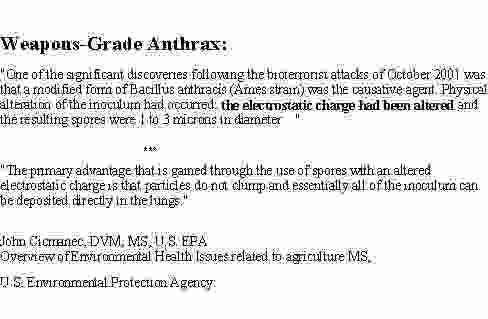
_________________________________________________________
Weapons-Grade Anthrax:
Summary of 2004 Environmental Health Conference
Introduction
The fifth annual Environmental and Occupational Health
conference, "Environmental Health Risk: Assessment, Management and Communications", was held from July 11-13,
2004 in Minneapolis, MN. The generous support provided by the Health Resources Services Administration, the Centers for Disease
Control and Prevention, and the National Institute for Environmental Health
successful yet. We would also like to acknowledge NSF
International for their support of the conference. The efforts of the Association of Schools of Public Health Environmental
and Occupational Health Council resulted in a valuable and memorable experience for all the participants.
The presenters were:
John Cicmanec, DVM, MS, U.S. EPA
Overview of Environmental Health Issues related to agriculture John L. Cicmanec, DVM, MS,
U.S. Environmental Protectio Agency:
Weapons-Grade Anthrax:
The Infectious Dose-50 in
Rhesus Monkeys Derived from a
Biologically-based Model for Use
in Human Risk Assessment
One of the significant discoveries following the bioterrorist attacks of October 2001 was that a modified form of Bacillus
anthracis (Ames strain) was the causative agent. Physical alteration of the
inoculum had occurred; the electrostatic charge had been altered and the resulting spores were 1 to 3 microns in diameter.
Eight separate inhalation studies have been identified in which non-human primates were used for inhalation exposure to B.
anthracis to
determine the Infectious Dose50 ( Druett 1953, Henderson,1949,
Estep 2003,etc.) Depending on the spore particle size and strain
used, these values ranged from 4000 to 682,000 spores. Although some studies used spores that were one micron in diameter,
conventional spore preparations will aggregate so that many of the inhaled particles will often range from four to twelve
microns. The primary advantage that is gained through the use of spores with an altered electrostatic charge is that particles
do not clump and
essentially all of the inoculum can be deposited directly in the lungs.
In order to adjust for the amount of the conventional inoculum in the non-human primate studies that was deposited in
nasal passages, pharynx, and tracheobronchial regions, a methodology that has been developed for chemical particulate inhalation
exposure (using the MMAD and sigma g) has been used as a model. Conveniently, cadmium chloride and radio-labeled polystyrene
microspheres share
the same target cell, alveolar macrophages, as anthrax spores.
Through the use of ranking the dose response of these two surrogates and zones of deposition in the respiratory tract,
similar dosage adjustments can be made for anthrax spores of various particle sizes. Use of this model enables us to predict
that the ID50 for the modified form of anthrax is at least 15 to 500 times lower than for conventional spores. (This presentation
does not represent
US EPA policy)
___________________________________________________

_________________________________________________________
Novel Magnetic Silica
Biotechnology and Bioengineering
Volume 37, Issue 7 , Pages 614 - 626
Published Online: 18 Feb 2004
Copyright © 1991 John Wiley & Sons, Inc.
Article
A novel magnetic silica support for use in chromatographic
and enzymatic bioprocessing
Victor Goetz, Magali Remaud, David J. Graves
Department of Chemical Engineering, University of Pennsylvania, Philadelphia, Pennsylvania 19104-6393
__________________________________________________________
|

